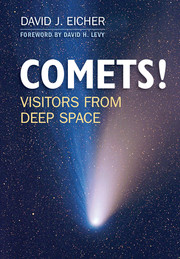Book contents
- Frontmatter
- Dedication
- Contents
- List of Figures
- List of Plates
- Foreword
- Preface
- Acknowledgments
- 1 Strange Lights in the Sky
- 2 Great Comets
- 3 What Are Comets?
- 4 Comets of the Modern Era
- 5 Comets in Human Culture
- 6 Where Comets Live
- 7 The Expanding Science of Comets
- 8 Observing Comets
- 9 Imaging Comets
- Glossary
- Bibliography
- Index
- Plate Section
4 - Comets of the Modern Era
Published online by Cambridge University Press: 05 October 2013
- Frontmatter
- Dedication
- Contents
- List of Figures
- List of Plates
- Foreword
- Preface
- Acknowledgments
- 1 Strange Lights in the Sky
- 2 Great Comets
- 3 What Are Comets?
- 4 Comets of the Modern Era
- 5 Comets in Human Culture
- 6 Where Comets Live
- 7 The Expanding Science of Comets
- 8 Observing Comets
- 9 Imaging Comets
- Glossary
- Bibliography
- Index
- Plate Section
Summary
The last Great Comet we explored was Comet Skjellerup-Maristany (C/1927 X1), which lit up Earth’s skies during the final weeks of 1927. If we fast-forward 30 years, we come to the first Great Comet of the modern era, Comet Arend-Roland (C/1956 R1). Belgian astronomers Sylvain Arend (1902–1992) and Georges Roland (1922–1991) discovered the comet on photographic plates made on November 8, 1956. At the time of discovery, Arend-Roland already glowed at 10th magnitude and had a short tail. But the astronomers delayed announcing the discovery until November 19, and thereafter other images of the comet turned up, as early as September 11, 1956.
Comet Arend-Roland brightened slowly. Its orbit made clear that the comet would pass closest to Earth on April 21, 1957, at a distance of 85.3 million km. This followed its closest passage to the Sun on April 8. By year’s end 1956 Arend-Roland was glowing at about 9th magnitude and sported a tail stretching just 8 arcminutes long. The first few weeks of 1957 saw the comet continue to brighten slowly, reaching magnitude 8.5 by late February. By February 27, the comet slipped too close to the Sun to observe, and astronomers had to wait until it reemerged in the morning sky.
- Type
- Chapter
- Information
- COMETS!Visitors from Deep Space, pp. 71 - 93Publisher: Cambridge University PressPrint publication year: 2013



